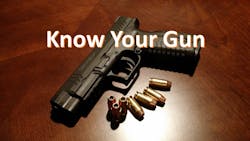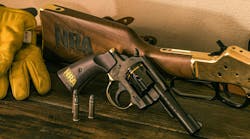Many of us are “gun nuts,” we enjoy shooting, and handguns have evolved so much in the past 50 years that virtually all manufacturers are creating truly fine working weapons. We often talk about our guns with our colleagues, both while we’re working and when we’re not. We boast about any newly acquired weapons and readily show them off to others.
Don’t get me wrong, I enjoy examining and shooting different handguns from the big, bad .45s to the tiny derringers. They’re all fun to shoot. But when it comes to using the weapons on the job and/or off-duty it’s imperative that you know that gun inside and out. I’ve had the experience of working as a firearms instructor for close to two decades. What I’ve seen on the range from self-described firearms experts sometimes scares the dickens out of me. Guys talk about the benefits of a certain firearm and its capabilities and about how this particular gun is a game-changer on the street. Once I put them on the firing line, however, it often turned into a disaster that ranged from not being able to control the weapon with mostly inaccurate shots, to being puzzled about the actual operation of the weapon. To make matters worse, they insisted they would carry the new gun either on the job or off-duty.
Knowledge is a powerful thing - in anything we do. Whether that knowledge is about how we do our job, or the tools we use to do it. One of the most important tools is the sidearm we’re carrying. It has the power to end a life or save one. In a critical situation, there’s no time to think about which gun we’re carrying and how it operates. No time to remember how we’re carrying it if we’re off-duty. Is it in a pocket, waist band or holster, right side or left? Is the gun I’m carrying today the one with the manual safety or not? There’s no time to think about these questions, only time to draw and address the situation. Once in your hand, that gun becomes an extension of you. The operation becomes instinctive, that is, you look through your weapon at what is unfolding in front of you. Any firing or other manipulations happen automatically. Malfunctions, reloads, or whatever, are things that are rectified without any thought process. It all happens automatically because you’ve become so familiar with that gun that you can operate it under any and all conditions.
So how do we get to that level? How do we reach the point of having that weapon in hand and not even remembering how it got there? Practice, practice, practice. To think you can achieve any level of familiarity of confidence with a gun without having practiced until you’re almost bored is lunacy. Live fire, along with dry fire are equally important. Live fire for the muscle memory of presenting the gun and the feel of the discharge and felt recoil . . . the sights, trigger squeeze, coming back on target after multiple shots, those must be repeated actions that become second nature. Dry fire helps us make the gun comfortable in our hands while we practice drawing, acquiring a sight picture, and working with the trigger.
On the firing line is when we learn whether our chosen method of carry will work. Warm weather versus cold, heavy clothing versus t-shirts, etc. If you don’t practice under the conditions with which you will be deploying your weapon, expect to be farther behind the reactionary curve. You don’t want to give a potential adversary any more advantage than you must. What are the possible problems that you may encounter? Think about them and eliminate them at practice, not when the incident unfolds. Does your gun have a hammer that might get hung up on clothing when you try to present? Are you wearing your gun in a different place each time you leave the house? Are you carrying different weapons? If so, are you instinctively familiar with each one?
Unfortunately, we can’t expect to reach the level of competency that enhances our capability with our weapon by simply attending our department’s mandatory range dates. Depending on funding, quals vary from once per year to quarterly. Being on the range is always a time when we discover our shortcomings and sometimes our strengths. But range time offered by our departments is never enough. If you truly want to be instinctively familiar with what you carry, spend time working with the gun in your hand. Know how it feels with a one or two-handed grip, the weight of the trigger pull, the transition trigger, double to single, any safeties, slide locks, mag exchanges, mag releases—every aspect of the gun must be imprinted indelibly in your mind so that when that critical incident begins, you’re in the game immediately!
Stay safe, Brothers and Sisters!



